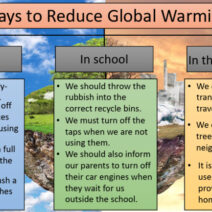Climate change, a monumental challenge of our time, necessitates a multifaceted approach. The scientific consensus indicates that human activities, particularly the combustion of fossil fuels and widespread deforestation, are primary drivers of this crisis. Addressing climate change is not merely an environmental imperative; it is essential for the health of our economies and communities. Fortunately, there are numerous real solutions on the horizon. This discourse will explore actionable strategies across various sectors that can serve to mitigate the adverse impacts of climate change.
Transitioning to Renewable Energy
One of the most critical pathways to combat climate change involves a decisive transition from fossil fuels to renewable energy sources. Solar, wind, hydroelectric, and geothermal power present sustainable alternatives that can drastically reduce greenhouse gas emissions. Investments in solar and wind energy have seen exponential growth in recent years, leading to significant reductions in costs and advancing technologies. For instance, the efficiency of photovoltaic cells continues to improve, and the installation of wind farms has become ubiquitous in many regions.
Utilities are beginning to shift towards grid independence and decentralized energy systems. This transition not only mitigates emissions but also enhances energy security. As storage technologies, such as batteries, evolve, the feasibility of integrating renewable sources into the broader energy grid will improve, providing a reliable and sustainable energy future.
Enhancing Energy Efficiency
Another pillar in the fight against climate change is the enhancement of energy efficiency across various sectors. Buildings account for a considerable portion of global energy consumption. Retrofitting existing structures to meet stricter energy efficiency standards can yield substantial reductions in energy use. For example, incorporating energy-efficient lighting, insulation, and heating systems can help slash energy bills while minimizing environmental footprints.
Moreover, the transportation sector presents a significant opportunity for efficiency improvements. Transitioning to electric vehicles (EVs) and improving public transportation systems can reduce dependence on fossil fuels. Urban planning that prioritizes walkability and cycling can also contribute remarkably to lowering emissions from personal vehicles.
Implementing Carbon Capture Technologies
Carbon capture and storage (CCS) technologies have emerged as a crucial method to mitigate atmospheric CO2 levels. By capturing carbon dioxide emissions at their source—such as coal-fired power plants—and storing them underground, it is possible to prevent large amounts of greenhouse gases from entering the atmosphere. Research is ongoing to enhance the efficacy of these technologies, making them more economically viable and widely implementable.
Moreover, innovative strategies such as direct air capture (DAC) and bioenergy with carbon capture and storage (BECCS) are gaining traction. DAC involves removing CO2 directly from ambient air, presenting a unique solution that could help tackle emissions from hard-to-decarbonize sectors, while BECCS integrates carbon capture with biomass energy production, providing a dual benefit of generating energy and sequestering carbon.
Promoting Sustainable Agriculture
A substantial contributor to climate change lies in our agricultural practices. The sector is responsible for significant emissions, particularly methane and nitrous oxide. Transitioning to sustainable agricultural methods can reduce these emissions while increasing food security. Practices such as regenerative agriculture, which emphasizes soil health and biodiversity, enhance carbon sequestration while optimizing productivity.
Additionally, reducing food waste is imperative. Approximately one-third of all food produced is wasted, contributing to emissions through decomposing organic matter in landfills. Efforts to streamline supply chains, improve storage facilities, and enhance consumer education can diminish waste and, consequently, its climate impact.
Encouraging Afforestation and Reforestation
Forests act as carbon sinks, absorbing significant amounts of CO2 from the atmosphere. Afforestation—the establishment of forests in non-forested areas—and reforestation—the replanting of trees in deforested areas—are crucial measures to increase biomass and enhance carbon storage. These initiatives also bolster biodiversity, improve air quality, and promote water conservation.
Community involvement in tree planting initiatives can foster environmental stewardship and awareness. Programs designed to incentivize reforestation and sustainable forestry management can facilitate long-term environmental benefits while providing economic opportunities for local communities.
Legislative Action and Policy Changes
The role of governments in combatting climate change cannot be understated. Comprehensive policies that establish standards and provide incentives for renewable energy development, energy efficiency improvements, and sustainable practices in agriculture are vital. Implementing carbon pricing mechanisms can encourage industries to internalize the environmental costs of their activities, shifting towards cleaner alternatives.
International cooperation is equally critical. Climate agreements, such as the Paris Agreement, aim to unify countries in their efforts to limit global warming. These frameworks set ambitious targets for emissions reductions while promoting technology transfer and financial assistance for developing nations to adopt sustainable practices.
Engaging Communities and Individuals
Grassroots movements play a complementary role in addressing climate change. Individuals can contribute significantly by modifying their lifestyles to reduce their carbon footprints. Simple choices, such as minimizing energy use, reducing meat consumption, and utilizing public transport, collectively yield meaningful impacts. Educational campaigns can raise awareness and drive community engagement, inspiring collective action towards sustainability.
Moreover, businesses are increasingly recognizing the importance of corporate social responsibility, adopting sustainable practices along their supply chains and committing to carbon neutrality. This paradigm shift can result in substantial reductions in emissions while fostering consumer trust and loyalty.
In conclusion, the quest to fix climate change is complex, demanding multifarious solutions that integrate technological innovation, policy reform, and community engagement. By embracing these strategies comprehensively, it is possible to tackle the climate crisis effectively. The future hinges on our commitment to these solutions, ensuring a sustainable planet for generations to come.



